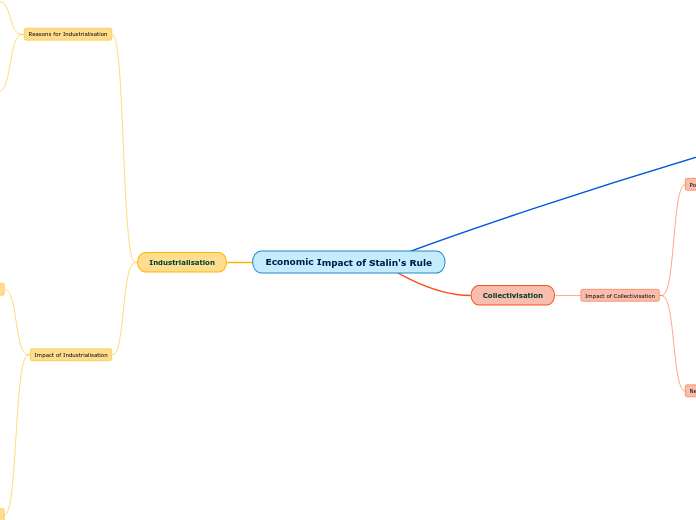by Valerie Foo 3 years ago
398
Economic Impact of Stalin's Rule

by Valerie Foo 3 years ago
398

Lives for workers were worse than Tsarist regime
There were poverty , starvation and suffering more prominent .
Caused great inconveniences and affected standard of living
Workers suffered hardship due to the lack of basic consumer goods .
Escalating prices due to shortages (1928-1933)
Purchasing power of workers´ salaries fell by 50%
Bad living conditions
Industries that produced basic goods were neglected.
The shortage of food , clothes , shoes were rationed
Worsened plight of workers (short-term)
Severe restrictions placed on workers (Short-term)
All factory workers had to work for 7days per week. Not allowed to move around factories during working hours.
If workers break rule , they would be sent to prison If workers steal things from factories , they would be sentenced to death If workers miss a single day of work , they would be fired
Industrialisation improved living conditions over time
Production of basic good increased, more supplies became available to people, rationing ended in 1936.
Workers received cheap meals and free uniforms, free education, subsidised healthcare, provision on extensive leisure facilities like cinemas, public parks, sports fields and gymnasiums
Government started campaign to teach Russian workers new skills to tackle problems of an uneducated workforce
Attending primary school was compulsory New schools,colleges and universities were built Thousands of teachers,scientists and engineers were trained
By 1930s, Russian workers were able to obtain well-paid, high-skilled jobs
strengthed russia's economically
Stalin´s policy of industrialisation strengthened Russia economically
By 1940, USSR overtaken UK in iron and steel production and became major industrial power.
Factories in cities produces equipment for mechanisation of farming;tractors with equipment , more moved from country to city.
First Five-Year plan((1928-1932) : Focused on heavy industries Next two Five-Year Plans (1933-1937)(1938-1941): Focused on consumer goods and heavy industries.
Main aim of FYP (1928-1932) was to rapidly industrialise USSR so as to become a military and economic socialist power to rival capitalist countries.
improved workers living standards
To ensure that targets meet, Communist governments implemented a system.
A system of rewards and incentives, where the more a worker produced, the more salary he earns/hard work rewarded with medals and holiday at a discount
strengthened russia millitary
Through industrialisation, Stalin strengthened USSR military
Ensured that USSR was ready for attack from Germany in 1941
Many new towns and industrial cities were built in the East
A strategic location placed them beyond the reach of Western invaders.
Ensured that the production critical to war efforts would not easily sabotaged.
Economic plans focused on developing heavy industries
Stalin ensured USSR has necessary economic resources for modern industrial war.
Five-Year plans were introduced by Stalin to industrialise USSR .
High targets were set for production of farm equipment to modernise farming
Through rapid industrialisation, Stalin wanted to produce equipment for mechanisation of farming
So that he could free up more labour and produce more food to support factory workers
Five-Year plans focused on the development of heavy industries like iron, coal, electricity, transport and power supply.
During Stalin´s rule , emphasis on development of heavy industries like electricity , iron and steel-high production targets were set for various industries
Stalin introduced Industrialisation to make USSR stronger
So as to compete with not risk being defeated by Western countries.
Producing key resources , strengthening industrial capacity and defence industry , rapid industrialisation would strengthen USSR.
Can close development gap between USSR and the West.
Development of heavy industries enabled USSR to develop own industrial base for arms production and build up military strength
Industrial workforce expanded and many industrialised cities like Magnitogorsk set up.
persecution of kulaks.
stalin's liquidation of kulaks worsened their lives - lost their wealth and property, lived in constant fear of being tortured, deported or killed
by 1935 almost all farms were kolkhozes; peasants who opposed were dealt with harshly. possesions taken away.
stalin had those who resisted shot or sent to gulags, >7 mil kulaks and their fam killed or deported to siberia or sent to labour camps. to be slave labour.
When collectivisation was introduced, many kulaks defied by slaughtering their livestock 100 mil sheep and goats, 16 mil horses, and burning grains instead of them up to collective farm.
great famine
great famine caused much hardship and misery to the people. many suffered from malnutrition.7 mil died.
between 1932-1934, severe famine resulted from poor harvest and food shortage almost 7 mil peasants died from starvation; instead of distributing stockpiled grain to staving people. stalin exported to foreign countries to raise fund to buy machinery.
collectivisation failed to increase agricultural production. grain harvest drop drastically between 1931- 1934. did not recover.
supported industrailisation
kolkhozes to be run by communist party merging farms made it easier for stalin to implement state intiatives and control peasants and their production.
implemented collectivisation to increase agricultural production and feed workers in industrial towns.
modernised farming.
production of machinery led to modernisation of farming and greater work efficacy. freed up peasants from farms to factories; provide much needed labour for industrailisations.
kolkhozes given machinery like tractors. peasants taught mordern farming methods, fertilizers, handling modern mchine, inc^ productivity. and replaced 17 mil peasants who left farms to work in industries,
concept of collectivisations to merge small indiv. famrs into larger farms, kolkhozy. ownership of farms of individual peasants (kulaks) to the state.
soviet farms were inefficient, production was little. and could only sustain the farmer.